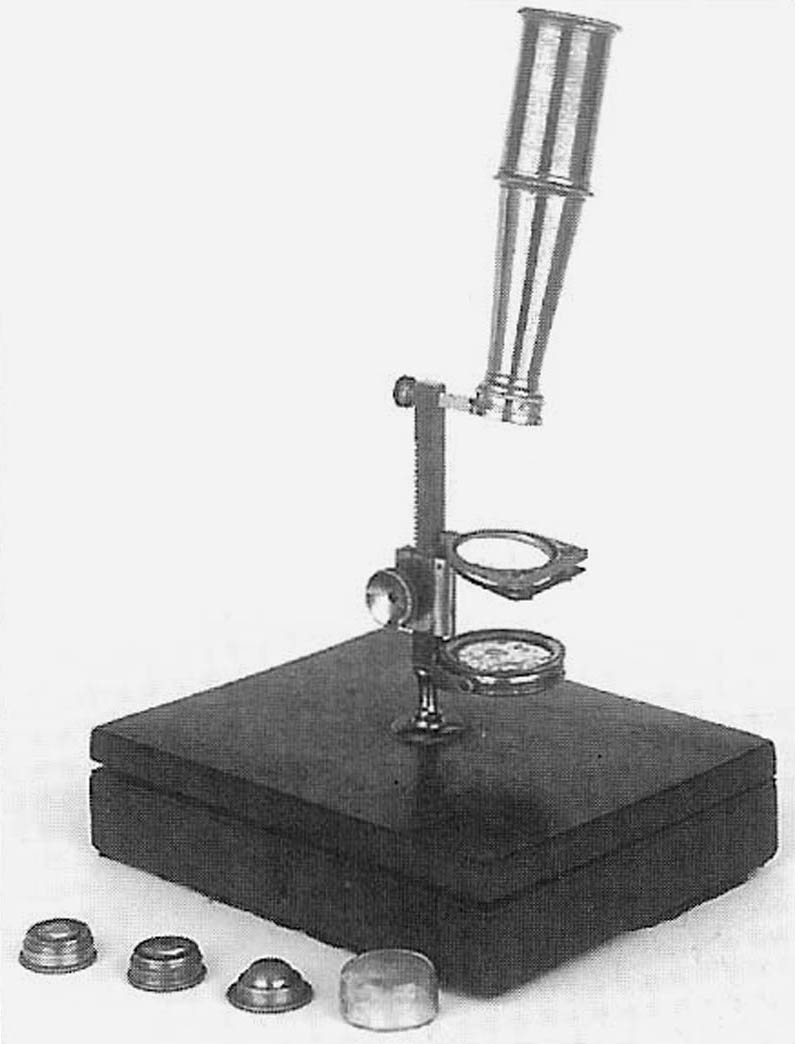
Figure 1. An "Adams / Jones Improved" microscope, made by John Tuther. It is engraved with the address “King Street, Bloomsbury, London”, thereby dating it to before 1819.
John Penn Tuther, 1774 - 1827
by Brian Stevenson
last updated September, 2025
A survey of 1820s London, England, street directories, insurance accounts, and other records revealed that there were approximately 27 manufacturers who could be described as makers of “mathematical and optical instruments” (Barnett, 1996). These included specialists and generalist, producing instruments such as microscopes, telescopes, barometers, thermometers, drafting tools and/or equipment for analysis of chemical and physical properties. Judging from insurance records, one of the largest manufacturers of that time was John Tuther, who in 1820 insured his stock and tools for £1580 and his premises for £50. In contrast, the average mathematical and optical instrument maker of the time carried an insured capital of £359, and the median was only £160.
Some of Tuther’s microscopes, telescopes, barometers and other scientific equipment still survive, mostly in museums, although they are occasionally seen at auctions. Overall, Tuther’s products are similar is style to those of other manufacturers of his time (Figures 1-8). However, they do provide some important insight on the development of microscope styles.
John Tuther opened his shop around 1815, noting that he was not listed in the 1814 Post Office Directory of London. He moved the location of his shop in ca. 1818, from 64 Upper King Street, Bloomsbury, London, to 221 Holborn, London. The 1819 Post Office Directory of London indicates that he was certainly located on Holborn during that year. The address engraved on his instrument thus permits one to determine whether a microscope was made before or after that date.

Figure 1.
An "Adams / Jones Improved" microscope, made by John Tuther. It is engraved with the address “King Street, Bloomsbury, London”, thereby dating it to before 1819.
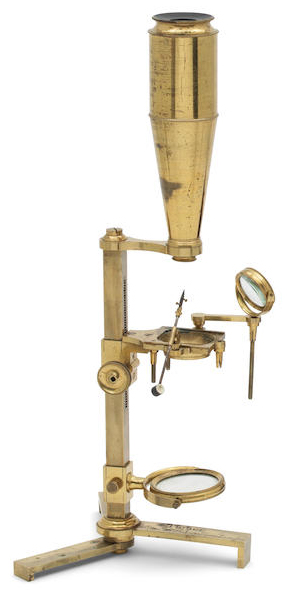
Figure 2.
A tripod-mounted microscope, patterned on the "Adams / Jones Improved" designs, from John Tuther. It bears his pre-1819 address of King Street, Bloomsbury, London. Image adapted from an auction catalogue, used for nonprofit, educational purposes.
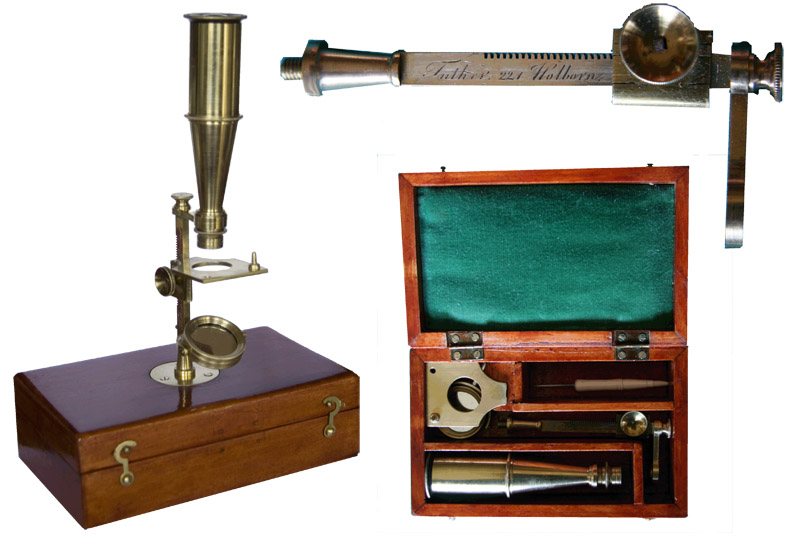
Figure 3.
A case-mounted microscope by John Tuther, with his pre-1819 address of King Street, Bloomsbury, London. Although microscopes such as this are oftern referred to as “Cary-Gould” (or “Gould” or “Cary”) types, it needs to be noted that Charles Gould introduced the microscope he designed for William Cary in 1826, at least 7 years after the production of this Tuther microscope. This and other microscopes from the first two decades of the 1800s demonstrate that Charles Gould based many features of his microscope on earlier models that were made by other manufacturers. Image adapted from an auction catalogue, used for nonprofit, educational purposes.
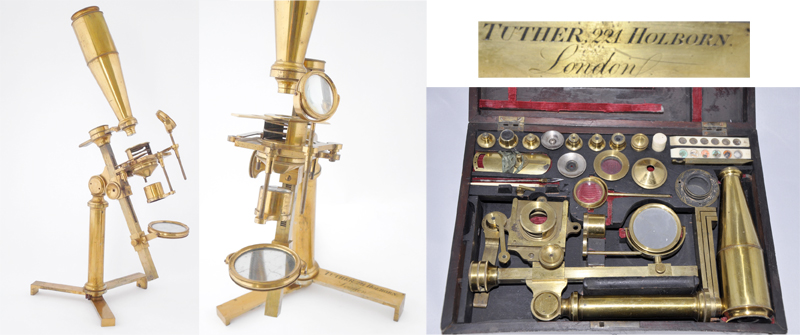
Figure 4.
A case-mounted microscope by John
Tuther. The engraved address of 221 Holborn dates this instrument to between
1819 and 1827. Images from
https://campus.usal.es/~histologia/museo/Microscopios/museo22c/museo22c.html,
used for nonprofit, educational purposes.
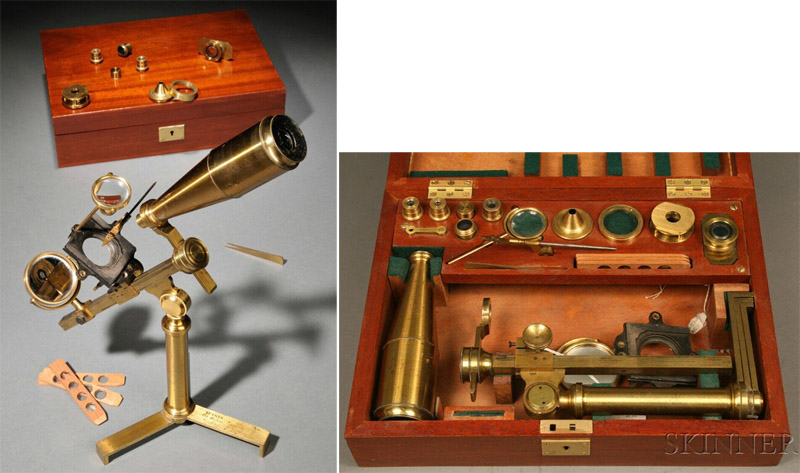
Figure 5.
An 1819-1827 free-standing Tuther microscope, engraved with his Holborn address. It is based on a pattern of George Adams, and generally known as “Jones Most Improved”. The London Museum of Science and History has two similar Tuther microscopes, engraved with his Bloomsbury address and therefore dateable to before 1819. Images by permission from Horst Kuhn’s excellent web site on early microscopes and other instruments, http://www.kuhn-scientificinstruments.de/photo-gallery.

Figure 6.
Another 1819-1827 Tuther microscope, also engraved with his Holborn address. Images from an internet auction site, used for nonprofit, educational purposes.

Figure 7.
A Tuther prospect glass – a small
telescope for watching theater. The 221 Holborn address dates this to between
1819 and 1827. Image from the Museum of the History of Science, used for
nonprofit, educational purposes.
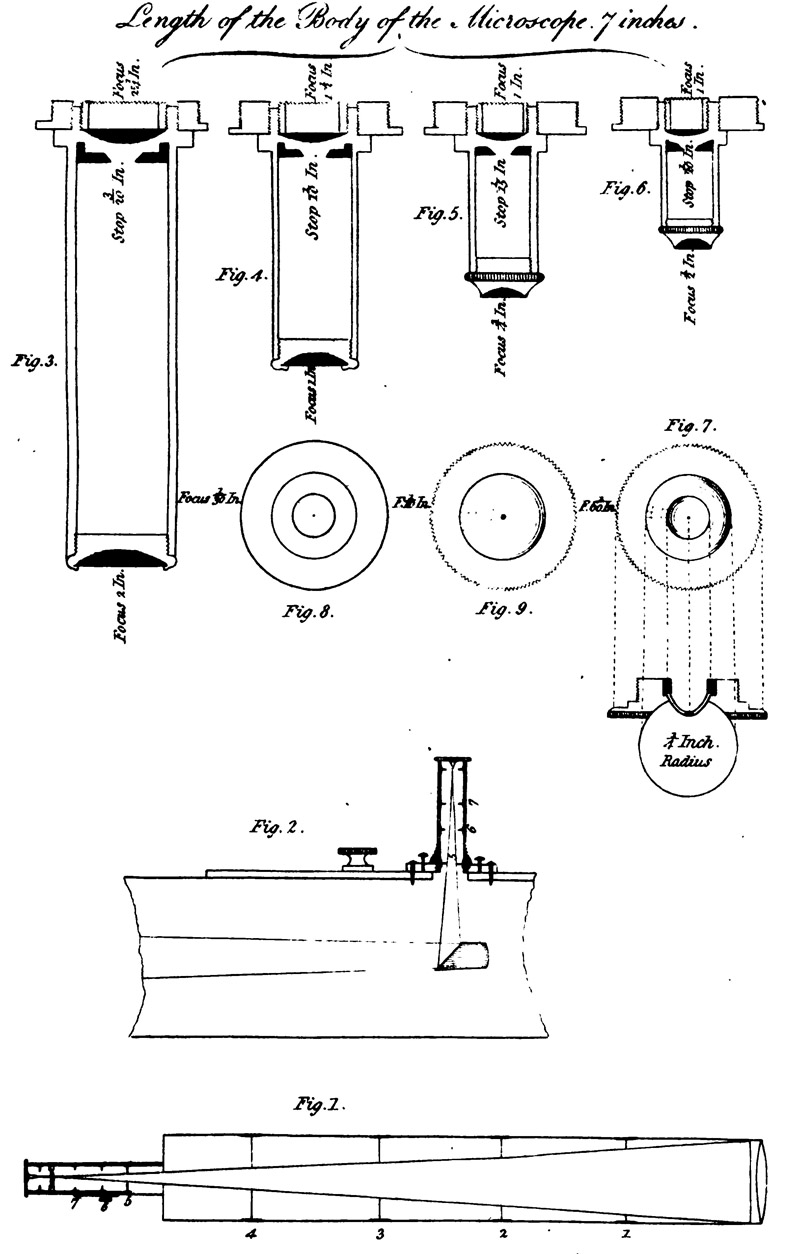
Figure 8.
A barometer by John Tuther, marked “Bloomsbury Up.r King Str.t London”, dating it ca. 1814 - 1819. Images from an internet auction site, used for nonprofit, educational purposes.
In addition to microscopes and other optical devices, Tuther regularly produced and sold a wide variety of scientific instruments. One of his barometers is shown in Figure 8. An 1819 publication noted that “Mr. Tuther, Philosophical Instrument Maker, High Holborn, has fitted up several electrical jars ... , using, however, tin foil upon paper for the coating around their outsides, instead of tinselled paper. The success has been complete; the unpleasant sensations occasioned by the passage of the electric fluid from common jars being entirely done away; whilst the most powerful effects are produced”. The address given is further proof that instruments labeled with Tuther’s Bloomsbury address were produced prior to 1819.
Tuther also manufactured custom instruments for scientific investigators. Although C.R. Goring famously collaborated with optician Andrew Pritchard on the construction of microscopes and the writing of several books on microscopy, Goring used the services of other manufacturers at various times. One such example is a set of lens holders that Tuther built in 1824 (Figure 9), described by Goring as, “In Figs. VII, VIII, and IX, are representations of some silver cups for holding very deep single lenses intended to view opaque objects, which, together with the object-glasses before-mentioned, were executed for me by Mr. Tuther, optician, in High Holborn, to whose, politeness and skill I am indebted for being able to carry my intentions into effect. It is generally supposed that single lenses will shew objects perfectly clear and without fog, but this is not the case unless their apertures are very small, - lenses of 1/30, 1/40, 1/50, and 1/60th of an inch focus require their apertures to be so much reduced to shew opaque objects clearly, that it is scarcely possible to see at all with them from the want of light. These cups were contrived to remedy this defect as far as it is practicable; their radius is only 1/4 of an inch, their focus consequently 1/8. These condense light much more than the larger cups commonly used, and illuminate much more powerfully. It is true that they only enlighten a small portion of an object, but then we can only see a very small portion with such deep lenses as they are intended to hold; they are not so small but that they may be made to receive and condense the whole of the light proceeding from a bull's-eye lens placed at a proper distance from them, and in this way with no other light than that of a common candle, I have been enabled to see well an opaque object with a compound microscope, having an object-glass of only 1/30 inch focus set in one of them, with only a moderate aperture. A lens of 1/60 inch set in this manner, used as a single lens, likewise shews opaque objects in a manner which leaves nothing to be desired”.
Figure 10 shows a drawing of an apparatus that Tuther produced in the early 1820s for Dr. William Prout, for determining the chemical composition of organic matter. Prout (1785-1850) recommended Tuther as an equipment source in his 1825 book on “Affections of the Urinary Organs”, writing, “Tests, Apparatus, &c. required in making Experiment on the Urine…A Bottle for determining the specific gravity of the urine; or what is better, a small portable hydrometer, made by Tuther, 221, High Holborn, for that purpose, and which is sufficiently accurate for practical use”. Tuther and Prout evidently had a close relationship, such that Tuther’s will left £20 to Prout.
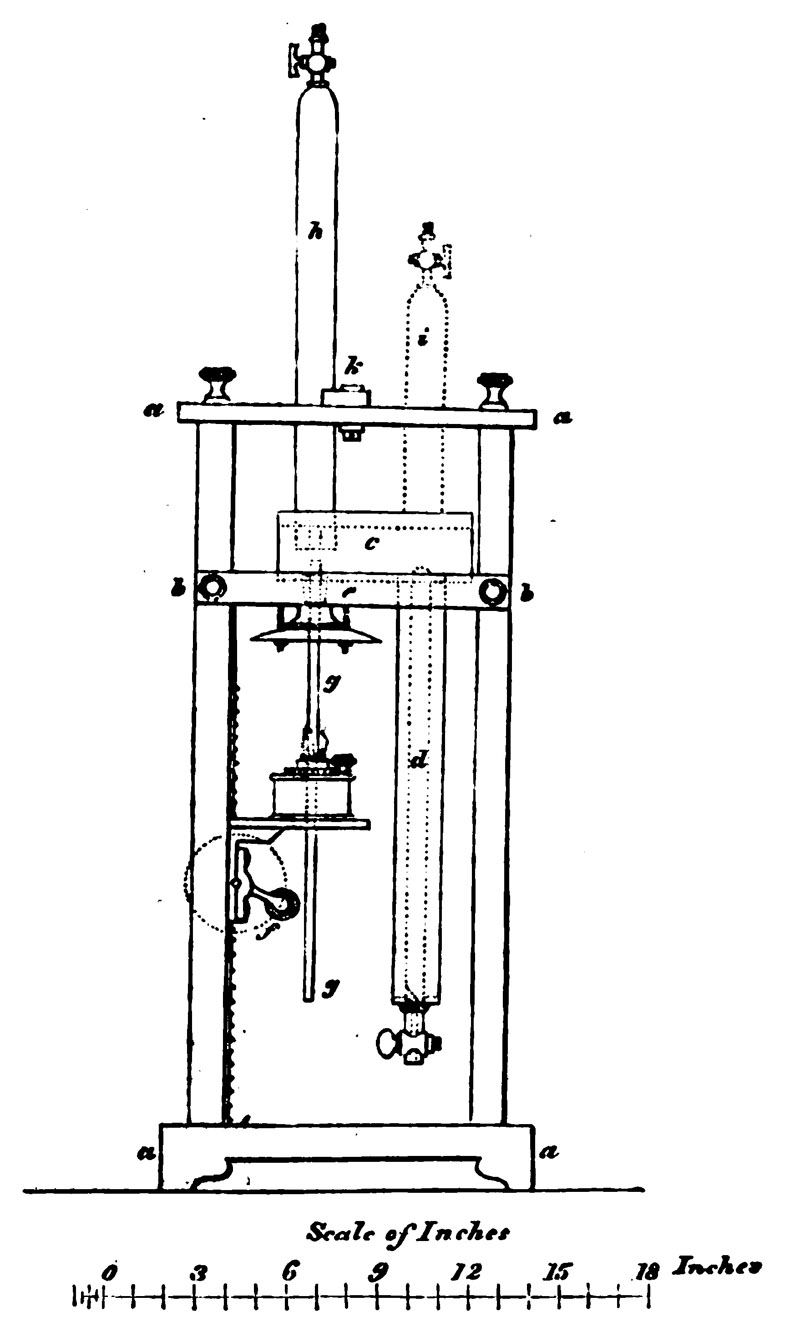
Figure 9.
An illustration that accompanied an 1824 paper on microscope development by C.R. Goring. John Tuther produced the silver lens holders labeled as 7, 8, and 9.
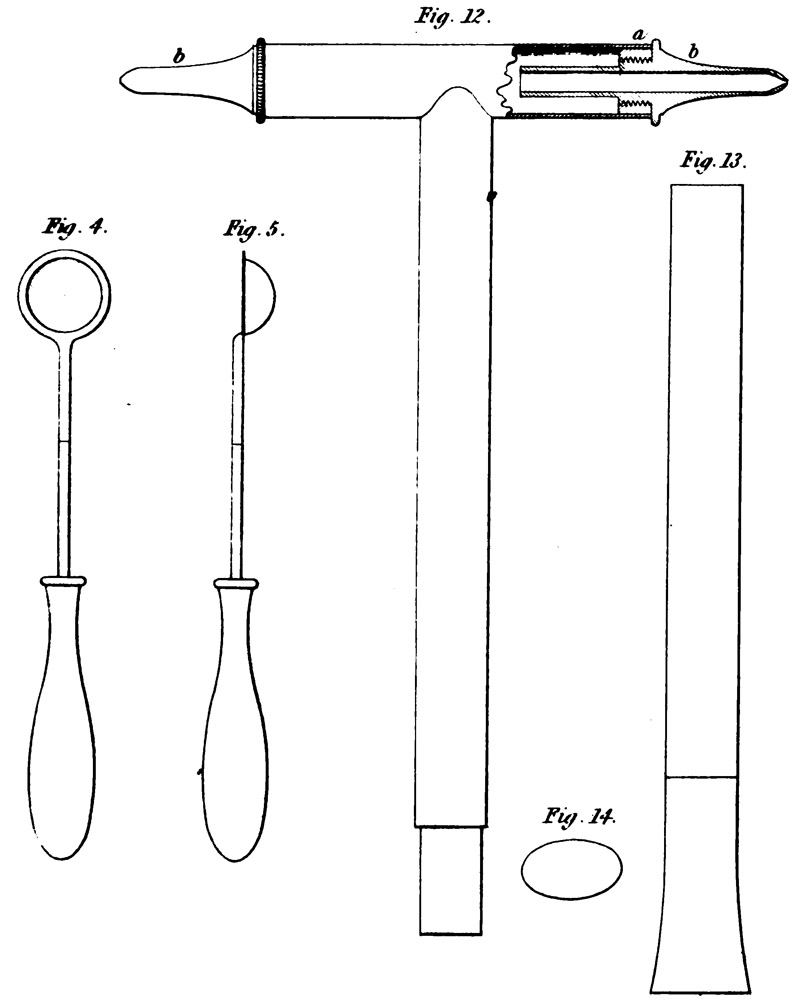
Figure 10.
Diagram of a device for analysing
chemical composition of organic material, produced circa 1823 from brass, glass
and wood by John Tuther for William Prout. Adapted from William Henry’s ‘Elements of Experimental Chemistry, Volume 2’, 1823.

Figure 11.
Diagrams of two other notable
instruments manufactured by Tuther, from ‘The Technical Repository’, 1822,
plate X: “An improvement on … thin platina spoons has been lately made by Mr. Tuther, Philosophical Instrument-maker, Holborn. It
consists in forming a flat rim around the margin of the spoon, which very much
assists in strengthening it and preserving its form. In Plate X. fig. 4 &
5, we have given a front and edge view of one of these improved spoons, with an
ivory handle”, and “Plate X, figs. 12, 13 and 14, represent Mr. Varley's
blow-pipe, of the full size of one in our possession, made by Mr. Tuther. The body of it is formed of thin brass tubes
soldered together; and the part fig. 13, fits upon the piece of small tube
inside the end of fig. 12, to lengthen it when used. The mouth-piece is of
silver, and is formed of an oval shape, as shewn in fig. 14. Into each end of
the cross-tube of the instrument, a brass block with a screwed hole in it, is
soldered, one of which is shewn in section at a. Into these holes two beaks, b, b, are screwed, having apertures
of different diameters; and also tubes, which project into the head, and
prevent the escape of the condensed vapour at the beaks”.
An indication of the breadth of instruments and supplies manufactured by Tuther is found in an 1824 accounting of purchases made in London for the University of Virginia. Tuther was paid £21, 16s, 6d for “decomposing cup for water by galvanism, pair of conducting wires silver mounted, flexible metallic tubes for transferring gas &c., gas receiver with stop cocks for collecting transferring gas &c., cast iron retort, wrought iron retort, deflagrating jars, glass alembic, copper alembic & refrigerator, portable furnace, Marcets apparatus for mixed liquids &c., syphons (glass), Mortars &c. (Wedgwood), crucibles of earth, iron, & muffles, lamp & apparatus, blow pipe, tongs & ladle, evaporating basin of porcelain, graduated measures, Welther’s tube of safety, hydrostatic balance with apparatus for specific gravity, capillary tubes of glass, and two thin, small, glass flasks for dissolving minerals”. It may say something about the emphasis of Tuther’s business and the quality of his optics to note that the University of Virginia also spent over £330 at William Cary’s for microscopes, telescopes, prisms, and such apparatus.
Tuther also prepared and sold objects for the microscope. Thomas Gill wrote in 1829, “Since witnessing Mr. T. Carpenter's admirable display of these vessels in the bodies of insects, the Editor has been induced to seek for them in objects where he had formerly overlooked them. And, in particular, in the tolerably transparent bodies of a bug and flea, of pretty large size, which had been mounted as transparent objects by the late Mr. Tuther, he finds the blood-vessels very distinctly visible, and curiously ramified, and particularly so in the body of the flea. Under the power of a single lens, the twentieth of an inch focus, in his Varley's microscope, the peculiar structure of the vessels is clearly discernible”. It is not clear whether Tuther mounted the insects on glass slides or between mica on ivory sliders. It is notable that Gill specifically stated the source of his specimens, implying a significant degree of quality.
Other records indicate that Tuther sold whole insects, and possibly other objects from nature. An often cited example is a specimen of a water beetle, reportedly captured circa 1814, and described as “Dr. Leach and Mr. Wilkin having purchased of Tuther, a dealer in Natural History, specimens which he assured them were taken near Wanstead House, Essex. The individual described and figured by me is in the cabinet of the Zoological Society, and Mr. Tuther received three guineas for that specimen!” The high price was a consequence of they being the only specimens of that species to be “caught” in Britain – later studies showed that they normally live in South Africa.
Tuther was clearly an avid entomologist. His will specifically mentioned his collection of moths. Tutt’s Natural History of the British Lepidoptera stated that "Tuther obtained a specimen (of a moth species) in London on June 27th, 1812”. He was cited as recommending the following gear for insect hunting, “Mr. Tuther formerly told me of a light-green coat with fifteen pockets for nets, &c., but a large fustian-bag for your nets, umbrella, &c., and an angler's basket for your boxes, vasculum (for sandwiches), and whiskey-flask (no bad accompaniment on the mountains)”. He was also mentioned in an 1834 article on ants, “We are told that a very grateful acid (the formic acid) is to be obtained from ants by distillation; and we find instances recorded of persons being fond of eating them alive. As Mr. Consett was walking with a young gentleman in a wood near Gottenburgh, in Sweden, he observed him sit down on an ant-hill, and, with a great degree of pleasure devour these insects, first nipping off their heads and wings. Their flavour, according to his account, was an acid, somewhat resembling, though much more agreeable than that of a lemon. The late Mr. Tuther, a celebrated optician in Holborn, assured that he had frequently eaten them in order to allay his thirst when in the woods”.
Of Tuther’s personal life, some facts can be gleaned from his will and other records, then correlated to government and church records. He stated, “I desire that I may be sacredly buried in the parish of Saint Clement Danes in the Strand as near as may be to the spot where my late mother Philippa Wade lies buried”. Philippa Wade, age 79, was buried in that cemetery on January 29, 1809. Her surname at death implies that she had remarried, presumably after the death of John’s father. According to age listed on John Tuther’s burial record, he was born in 1774. Joseph Tuther and Philippa Penn were married on November 20, 1774, at St Andrew Holborn. John’s middle name was “Penn”.
The will mentions Tuther’s schooling, “I give and bequeath to the parish School of St. Clement Danes aforesaid the sum of fifty pounds as a remuneration for the education which I received in the said school”.
There are no indications that John ever married or had children. Other than his dead mother, the will does mention any family.
With whom Tuther apprenticed is not known. His will includes two fellow opticians, at least one of whom was a former “shopmate”, and possibly a co-apprentice: “I give and bequeath to my old shopmate Edward Latchford now working with Mr. Banks optician in the Strand the sum of five pounds and to Charles Cuthbert of Great Bath Street Spafields the like sum of five pounds” (Figure 12).

Figure 12.
Excerpt from the probate transcript of John Tuther’s 1827 will, in which his “old shopmate” Edward Latchford, “now working with Mr. Banks optician in the Strand” and Charles Cuthbert of Great Bath Street, Spitalfields. Latchford (1775-1857) was recorded as being an "optician" at the time of his daughter's birth in 1814, but later operated a business that made bridle bits and spurs.
Tuther is not listed in the 1814 London Post Office Directory, suggesting that he did not have an independent business at that time.
An 1824 letter from John Lewthwaite implied that John Tuther was in business, or, at least, working as a scientist, in 1810. An excerpt, “Mr. W. says, the effects of electricity on loose gunpowder when transmitted through tubes of water, were communicated by me to Mr. L. some time previous to the publication of his letter. The natural inference to be drawn from this sentence is, that I am indebted to him for the experiment in question. This, I can assure Mr. W. is not the case; it was originally communicated to me by Mr. Tuther about fourteen years ago. The experiment relative to the conducting power of ether, alcohol, and acids, published in the Institution Journal, originated while I was experimenting with the water tube, nor had I the least idea that Mr. W. was investigating the conducting power of those fluids until some time after the publication of my letter”. Tuther would have then been approximately 36 years old, certainly old enough to have completed apprenticeship.
I have not located any records of when Tuther opened or closed his business at 64 Upper King Street, Bloomsbury. The 1819 Post Office Directory includes the entry, “Tuther John, Mathematical-instrument-maker, 221, Holborn”. Subsequent tax records also place him on Holborn. Curiously, two street directories, from 1822 and 1823, contain entries for “Tuther John, optician, 221, High Holborn” and “Turner John, optician, 64, Up. King-street, Bloomsbury”. No other records of optician John Turner have been located. He was not included in any known Post Office Directory, tax or poll book. These suggest that the street directory entries were due to a prior misprint of “Tuther” as “Turner”, with subsequent retention of “Turner’s” address under the assumption that he was a different individual. Eva Taylor’s The Mathematical Practitioners of Hanoverian England includes mention of John Turner, likely based upon the above-cited directories. The Adler Planetarium’s Webster Signature database also includes John Turner’s name and address, but references only Taylor’s book, and does not describe any known examples of Turner’s work.
In 1822, The Technical Repository reported, “Accident in Preparing Fulminating Silver. Mr. Tuther, the optician and philosophical instrument maker, of Holborn, in preparing this dangerous substance, on the 9th of September last, met with a serious accident, which at first threatened him with the loss of sight of his right eye; and from the effects of which he cannot, at any rate, recover for a considerable length of time. The nitric ether generated, by some means caught fire as it escaped at the mouth of the glass retort which he held in his hand, and communicating the flame to the contents of the retort, the whole exploded with a considerable report. We mention this accident, with a view to caution our readers in the preparation and use of this highly explosive matter, and from which so many accidents have occurred; too much caution cannot be taken to guard against mischief in treating it. Mr. Tuther, in spite of all his care, is an instance in point”.
Tuther issued a catalogue in 1823, described as “Tuther's Catalogue of Optical, Philosophical, and Mathematical Instruments; with a Descriptive Enumeration of the Apparatus employed in Experimental and Operative Chemistry, Analytical Mineralogy, and in the prosecution of the recent Discoveries in Electro-Chemical Science.”. The catalogue cost 1 shilling.
John Tuther prepared and signed his will on January 11, 1827. He was buried at St. Clement Danes 18 days later, on January 29, implying that his death was not unexpected. In addition to the above-described beneficiaries, Tuther left “to the workmen in my trade who shall be employed in my house at the time of my decease and have been in my employ twelve calendar months the sum of ten pounds each”, “to Maria Cooper my charwoman & washerwoman the sum of sixty pounds and likewise the articles she washes”, and £5 to an unidentified “Mr. Edward Williams of Hammersmith”. The remainder of Tuther’s money was given to his solicitor, Joseph Maberley. Additionally, Maberley “out of a sort gift may select of my philosophical instruments”. Maberley was a notable collector of antique prints, and author of The Print Collector. To Maberley’s son, Thomas Astley Maberley, Tuther gave “such articles as I may have at my decease that may be called curiosities such as moths animals and the like with the cabinets drawers and boxes in which the same may be found”.
Acknowledgements
Many thanks to Joe Zeligs for helping locate pictures of John Tuther’s microscopes.
Resources
Annals of Philosophy (1819) Vol. 13, page 390
Barnett, David (1996) Mathematical and optical instruments, in The Structure of Industry in London, 1775-1825, Ph.D. Thesis. University of Nottingham, pages 121-123
Blackwood's Edinburgh Magazine (1823) Monthly list of new publications, Vol. 14, page 108
Brewster, David (1832) The Edinburgh Encyclopedia, First American edition, J. and E. Parker, Philadelphia, Vol. 7, page 260
Curtis, John (1840) British Entomology, pub. by J. Curtis, London, pages 207-208
Curtis, John (1855) Notes on the Dytiscidae, Zoologist, Vol. 13, pages 4916-4923
Dale, James Charles (1838) Hints to young entomologists on catching, keeping, and breeding insects, The Naturalist, Vol. 3, pages 81-87
England birth, marriage, death, poll book, rents, and census records, accessed through ancestry.co.uk and findmypast.com
Gill’s Technological Repository (1829) On the blood vessels of the flea and bug, Vol. 3, page 262
Goring, C.R. (1824) On indistinctness of vision caused by the presence of false light in optical instruments, and on its remedies, The Quarterly Journal, Vol. 17, pages 202-209
Goring, C.R., and A. Pritchard (1837) Micrographia, Whitaker and Co., London, pages 3, 4, 23, 111, and 154
Henry, William (1823) The Elements of Experimental Chemistry, Vol. 2, Baldwin, Cradock and Joy, London, pages 162-172
History, Directory & Gazetteer, of the County of York (1822) “London, Opticians… Turner John, 64, Upper King street Bloomsbury … Tuther John, 221, High Holborn”, page lxiv
Kent’s Original London Directory (1823) “Turner John, optician, 64, Up. King-street, Bloomsbury” and “Tuther John, optician, 221, High Holborn”, pages 340 and 341
Lewthwaite, John (1824) Letter to the Editor, The Annals of Philosophy, Vol. 8, page 116
London Mechanics’ Register (1826) Mr. C. Gould’s portable compound microscope, June 10, pages 97-98
Maberley, Joseph (1844) The Print Collector, Saunders and Otley, London
The Magazine of the Beau Monde (1834) Vol. 6, page 102
The Medical Times (1850) Memoir of Dr. Prout, F.R.S., Vol. 22, pages 15-17
Piggot’s Directory (1839) “Opticians and Mathematical and Philosophical Instrument Makers … Cuthbert Charles 8 ½ Garnault pl. Clerkenwell”, page 171
Post Office Directory (1808) does not include Tuther
Post Office Directory (1814) does not include Tuther
Post Office Directory (1819) “Tuther John, Mathematical-instrument-maker, 221, Holborn”, page 350. (does not mention John Turner)
Prout, William (1825) An Inquiry into the Nature and Treatment of Diabetes, Calculus, and other Affections of the Urinary Organs, Second edition, Baldwin, Cradock, and Joy, London, page 318
Stephens, James Francis (1829) Illustrations of British Entomology, Vol. 2, Baldwin and Cradock, London, pages 67-68
Stephens, James Francis (1830) Illustrations of British Entomology, Vol. 3, Baldwin and Cradock, London, page 22
Taylor, Eva G.R. (1966) The Mathematical Practitioners of Hanoverian England, 1714-1840, Cambridge University Press, page 408
The Technical Repository (1822) Vol. 2, pages 286, 242, and 246
The Technical Repository (1824) Vol. 5, page 142
Tutt, James William (1904) A Natural History of the British Lepidoptera, Vo. 4, Swan Sonnenschein &Co., London, pages 194-195
University of Virginia Alumni Bulletin (1907) Vol. 7, pages 375-376
University of Virginia Founders Early Access (accessed January, 2015) “Francis W. Gilmer: Lists of Instruments to be Furnished to the University of Virginia by John Tuther and John Cary, ca. 15 Sept. 1824, 15 September 1824”, http://rotunda.upress.virginia.edu/founders/default.xqy?keys=FOEA-print-04-02-02-4546
Webster Signature Database (accessed January, 2015) John Turner, http://historydb.adlerplanetarium.org/signatures/edit.pl?edit_id=13776
Webster Signature Database (accessed January, 2015) John Tuther, http://historydb.adlerplanetarium.org/signatures/edit.pl?edit_id=13783
Will and Probate of John Tuther (1827) accessed through ancestry.co.uk
Pictures and information on John Tuther’s instruments (web sites active in January, 2015):
http://www.christies.com/lotFinder/lot_details.aspx?intObjectID=3770890, “A Gould-pattern simple/compound botanical microscope, with tapering body-tube on swiveling limb, stage and mirror, the pillar signed Tuther, King Str., Bloomsbury, London, with simple lens, three objectives and glass bowl in fitted mahogany case with mounting bush in lid.”
https://campus.usal.es/~histologia/museo/Microscopios/museo22c/museo22c.html, “Microscopio tipo Gould, firmado en el pilar Tuther, Holborn, London”
http://collectionsonline.nmsi.ac.uk/detail.php?type=related&kv=8057&t=objects, “Simple aquatic and dissecting microscope made by Tuther, 221 Holborn, London, before 1828, mahogany case, 8" x 5 1/4" x 1 3/4", lock, (with accessories)”
http://collectionsonline.nmsi.ac.uk/detail.php?type=related&kv=119303&t=objects, “Compound monocular microscope by Tuther, King Street, Bloomsbury”
http://collectionsonline.nmsi.ac.uk/detail.php?type=related&kv=118463&t=objects, “Jones-type compound monocular microscope in case, by Tuther, King Street, Bloomsbury
http://www.kuhn-scientificinstruments.de/photo-gallery, “Most Improved Type Compound Microscope signed by John Tuther c. 1820, Very rare brass microscope in its original case. Accessories: Fishplate, Lieberkuhn, Stage foreceps, Condensor lens, Stage magnifier, ivory slides, talc box”
http://collectionsonline.nmsi.ac.uk/detail.php?type=related&kv=3837&t=objects, “Single opera glass, with white ivory body covered with turned decoration, in red leather case, by John Tuther, 221 Holborn, London
http://collectionsonline.nmsi.ac.uk/detail.php?type=related&kv=8221686&t=objects, “Single opera glass, with white ivory body covered with turned decoration, by John Tuther, 221 Holborn, London
http://collectionsonline.nmsi.ac.uk/detail.php?type=related&kv=12706&t=objects, “Portable hydrostatic balance by Tuther, 221 Holborn, London, with six brass weights, small weights and forceps, glass plummet, bucket and jar, in mahogany case”
http://www.christies.com/lotfinder/lot/a-regency-mahogany-and-ebony-banded-4038207-details.aspx?intObjectID=4038207, “A Regency mahogany and ebony-banded stick barometer, circa 1820, With ivory-capped swan neck pediment, the ebony banded trunk with mercury thermometer and thumb-nail mouldings, (later?) turned cistern cover, silvered dial with Vernier scale and signed Tuther/Bloomsbury Up.r King Str.t/LONDON”